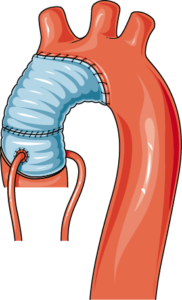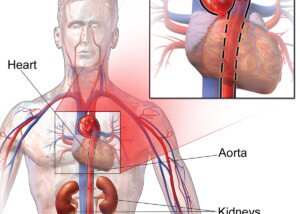When a thoracic aortic aneurysm is repaired, why are there still restrictions on lifting weights?
Isn’t the stent graft repair as good as the real thing?
Despite the marvel of stent grafting technology for repairing dilated sections of the thoracic aorta, this device is not as good as a healthy aortic wall, says Alexandra Kharazi, MD, a cardiothoracic surgeon with CVTS Medical Group, Inc., Chula Vista, CA.
It would seem, to the layperson who’s a muscle building enthusiast, that as long as a stent graft is in place, there is nothing to get ruptured or dissected from blood coursing through that sturdy stent during a weightlifting set.
You would think. But – it doesn’t work that way. And why isn’t it that simple?
“Good question. Stent grafting covers one aspect of the aorta: dissected or aneurysmal,” begins Dr. Kharazi.
“However, other portions of the aorta which are weakened are not stented.
“For example, someone may have a simultaneous ascending and descending aneurysm.
“The descending aneurysm may be stented, but the ascending aneurysm does not meet the criteria for open repair yet (usually fixed via open heart surgery as the standard treatment) and is still in the monitoring phase.
“Another example is someone who has a short-segment dissected area stented in an aorta which is aneurysmal throughout.
“However, even these examples aside, there are graft related complications that can occur in the setting of high blood pressure.
“These include leaks (‘endo leaks’) and migration, and can occur when the graft hasn’t fully integrated into the aorta yet or as delayed complications, particularly in patients with weakened aortas.”
An endo leak is when blood leaks into the aneurysm. This can be life threatening, and in some cases the first symptom is a rupture.
Migration is when the graft moves or shifts position, and there’s no way to guarantee that this will never happen during a blood pressure spike.
“High blood pressure can potentially compromise the seal of the stent graft,” says Dr. Kharazi.

Depiction of a graft sewn into the root of the ascending aorta via open heart surgery — which is the standard procedure for aneurysms in this area. The standard surgery for aneurysms in the descending portion is endovascular: accessing blood vessels through small incisions near the hip. Laboratoires Servier/CC BY-SA 3.0/Wikimedia Commons
But what if the patient doesn’t have those other issues?
• What if the graft has fully integrated into the aorta?
• What if the patient has only a descending aneurysm?
• What if the aneurysm is local rather than throughout (fusiform type)?
• What if the patient is otherwise in excellent shape and undergoes yearly scans to check for migration and endo leaks?
A physician may still want to “err on the side of safety and default to general guidelines,” says Dr. Kharazi, since there’s a lack of data on the long-term outcome of hardcore strength training with weights in people with a repaired TAA.
At the same time, it’s reasonable to wonder: What other reason could there be to have lifting restrictions when the above bullet points can be checked?
“We don’t know,” says Dr. Kharazi.
One reason for lack of data is because the typical TAA patient is not a strength training or muscle building enthusiast.
“But I can tell you what my concerns would be as a surgeon, and given the lack of specific guidelines, some of these concerns venture into conjecture based on my own experience,” continues Dr. Kharazi.
Stent Graft Integration
“We assume the stent graft has integrated after the initial healing period and can confirm with repeat CT imaging,” continues Dr. Kharazi.
“However, it’s hard to know the specific characteristics of a stent graft on a microscopic level.
“For example, in my practice, I have seen a recall of a stent graft for type 3 endo leaks.
“These are defects in the fabric itself. Luckily, this was caught and recalled, but not before I had implanted one myself.
“Given this, I am much more cautious with blood pressure guidelines in patients with implanted grafts, even when they ‘look great’ on imaging and are out of the initial healing phase.”
Stent Graph Fabric Isn’t As Strong As a Healthy Aortic Wall
“The stent graft fabric itself can become strained under a high blood pressure spike.”
Imagine that every time you go for your 5 RM deadlift or heavy hack squats, you must pray that the fabric in your stent graft holds up.
Blood pressure can significantly soar with other exercises as well such as during a heavily loaded floor leg press set, an intense bench press set and, needless to say, max reps of the back squat.

Shutterstock/Inna Vlasova
The incline press and overhead press with both barbells and dumbbells, among other popular movements, can also substantially raise blood pressure.
“Given the above, I would still say that if a stent graft looks good and we have all the reasons to think it’s well-incorporated and free of obvious defects on imaging, it is more tolerant of blood pressure spikes than the original aneurysmal aorta which it covers,” explains Dr. Kharazi.
But nothing beats nature’s design when it’s healthy.
Monitoring Blood Pressure in the Gym
The monitoring could become cumbersome and discourage finishing a routine.
Or, the athlete might end up skipping the monitoring for some exercises, not to mention forget to bring the monitoring device with him or her.
They’d be better off just paring down the load and intensity, and avoiding taking sets to muscle failure.
 Dr. Kharazi has many areas of surgical expertise including the following: aortic aneurysm repair, aortic valve repair and replacement, and CABG. Other areas of focus include arrhythmia, bloodless medicine, lung cancer and resection, septal defect repair and thoracic surgery.
Dr. Kharazi has many areas of surgical expertise including the following: aortic aneurysm repair, aortic valve repair and replacement, and CABG. Other areas of focus include arrhythmia, bloodless medicine, lung cancer and resection, septal defect repair and thoracic surgery.
 Lorra Garrick has been covering medical, fitness and cybersecurity topics for many years, having written thousands of articles for print magazines and websites, including as a ghostwriter. She’s also a former ACE-certified personal trainer.
Lorra Garrick has been covering medical, fitness and cybersecurity topics for many years, having written thousands of articles for print magazines and websites, including as a ghostwriter. She’s also a former ACE-certified personal trainer.
.









































